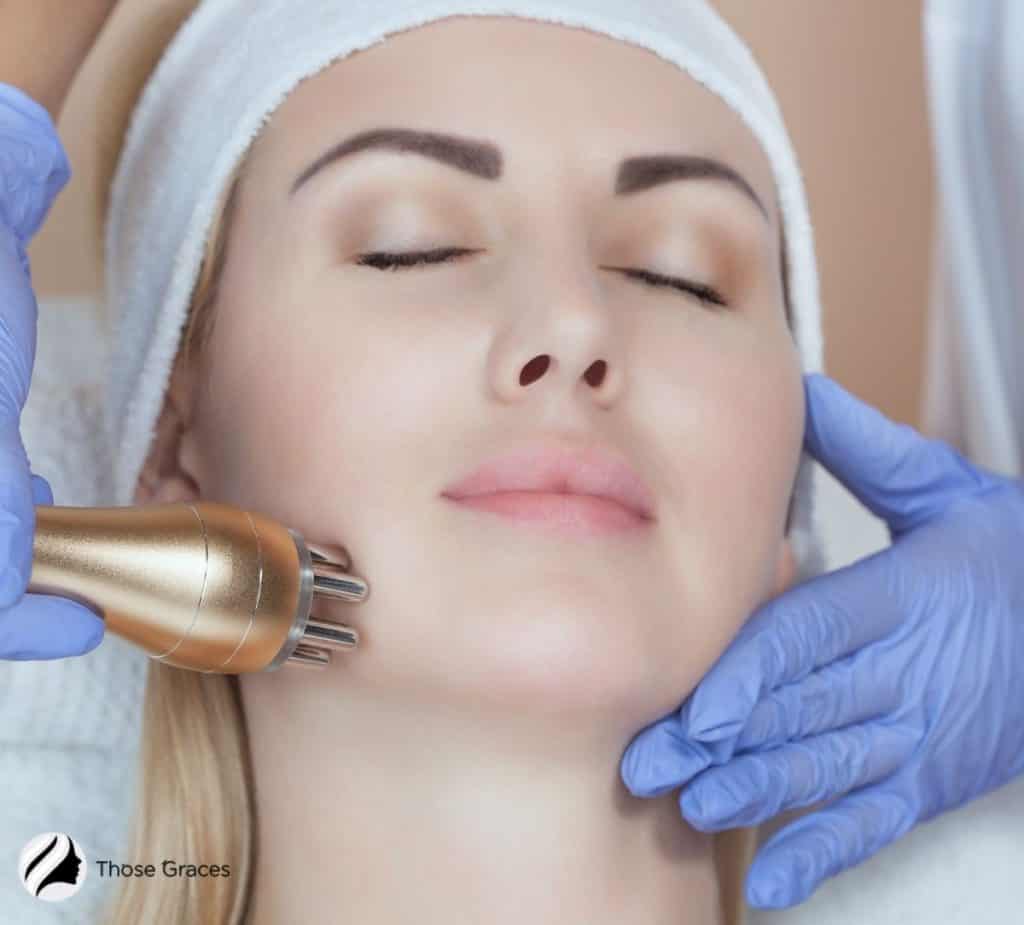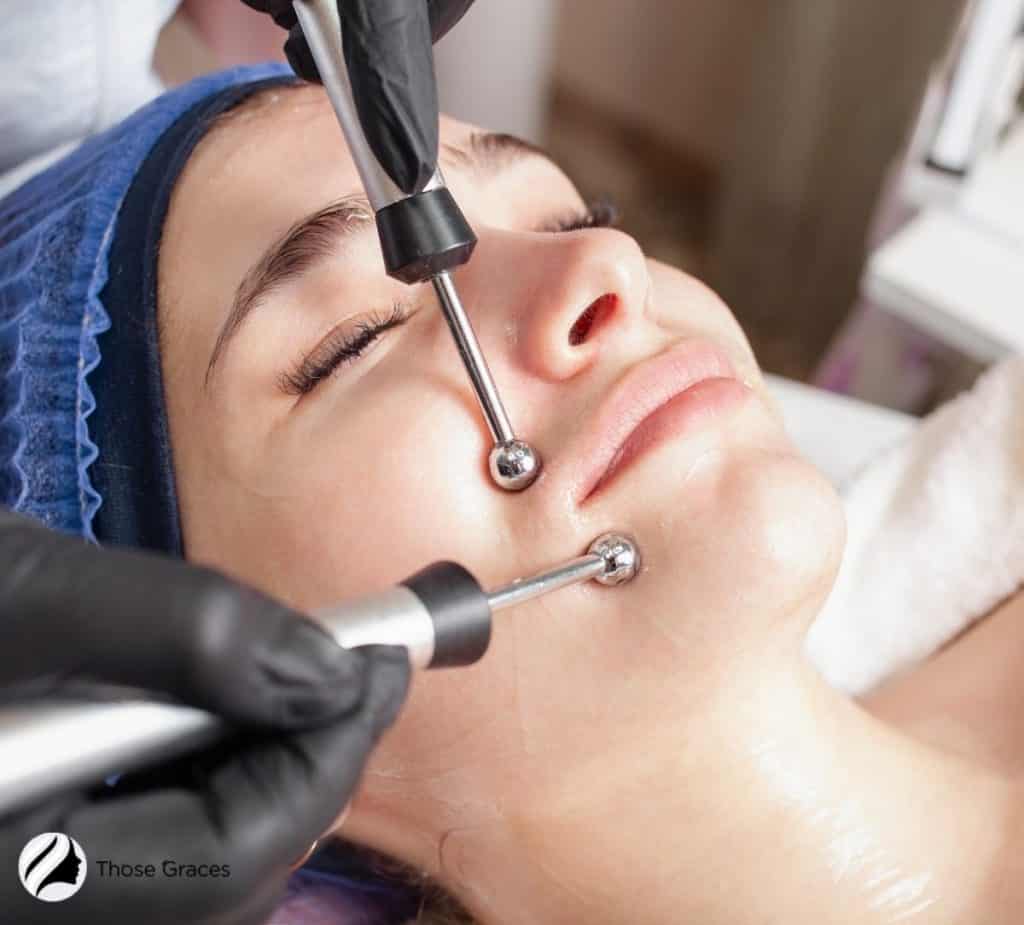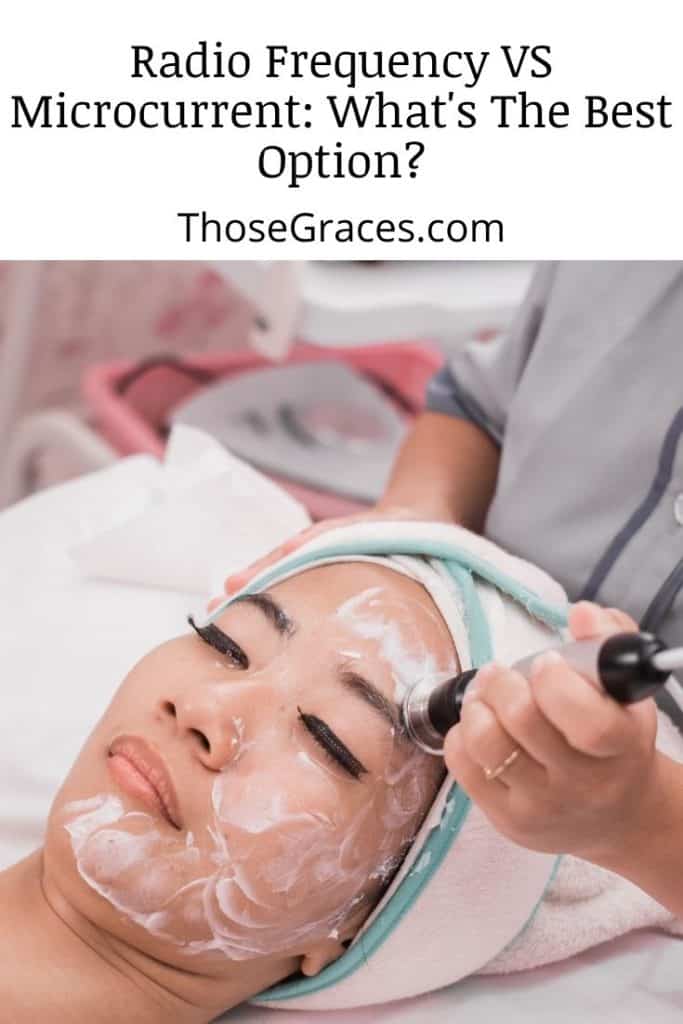Yes, both microcurrent and radio frequency treatments are excellent ways for facial rejuvenation of your skin health.
Still, they work in distinct ways for treating loose skin and act as a skin tightening treatment.
Both aim to improve cell turnover and aid collagen production. Do you have to choose between the two? Or is it possible to have the best of both worlds? Don’t worry!
In this post, we’ll learn more about radio frequency vs microcurrent technologies and their key differences for treating your facial muscles and skin’s adversaries, such as sagging skin, dry skin, loose jowls, and more!
So, let’s get started!
CHECK: Professional Microcurrent Machines to Try!
Table of Contents
What is Radio Frequency, and How Does it Work?
Radio Frequency is a kind of energy defined in wavelengths per second or “frequency.” This is similar to the sound waves emitted by your iPhone, sunlight, or wifi signals [1].
They’re all categorized as “electromagnetic spectrum” components.

The facial treatment is painless and risk-free for all skin types.
These low-powered electromagnetic waves can now be used to treat your skin tissue and facial muscles and increase the production of collagen on your skin.
Don’t be alarmed by the term “electromagnetic,” though; you won’t get burned!
Even celebrities like Amanda Holden and Kylie Minogue give rf devices credit for their flawless facial skin [2].
Clinical studies prove that radiofrequency therapies are easier to catch up with because they are in the lowest part of the electromagnetic spectrum [3].
Check out this awesome video on RF.
@hannahbaxward My third radio frequency microneedling appt and yes I’m still obsessed #radiofrequencymicroneedling #skincare #fyp #beautyeditor #microneedling ♬ original sound – hannahbaxward
MUST READ: Is Microcurrent Safe?
How Does Radiofrequency Treatment Work?
To put it another way, radiofrequency can heat up your skin. These facial devices generate enough electrical currents to heat and warm the deeper layers of the skin [4].
So here it goes, A board-certified cosmetic dermatologist will place an alien-looking gadget on your skin and hold it there until the treatment region is heated to 52 to 55 degrees Celsius.
The collagen fibers through collagen synthesis will be pushed back by the heat waves emitted by the device.
Furthermore, it will boost elastin production, the protein that gives the skin texture it’s rubbery feeling.
Here’s a video of how it actually works:
So, What to Make Out of it?
It is, in fact, as simple, painless, and convenient as it appears. It also ensures a high rate of cell turnover and an increased rate of collagen production in each layer of skin surface.
What distinguishes it from other therapies such as laser therapy? On the other hand, the technology and treatment are FAR less invasive [5].
In a few days after the treatment time, you’ll notice that you have smoother skin, dewy skin, and healthy muscles.
Check out the video below on what is radio frequency.
@aestheticsdyanna What is radio frequency ?..
♬ Forever – Labrinth
But don’t put too much faith in your eyesight. Although these professional treatments function at the cellular level, they can reveal naked visions.
READ MORE: How Long Does a Microcurrent Facial Last?
Here’s a quick peek at the difference between high-frequency and radiofrequency facial.
High Frequency Facial
- – Uses fractional ultrasound energy that is more accurate and intense
- – Clinical proof says that HIFU can reach the SMAS layer
- – Typically conducted in a single session
Radio Frequency Facial
- – Uses light treatments and bulk heating methodsFive free tickets per special exhibition
- – It is limited to the epidermal layers and does not reach the deep dermis
- – May require 2-3 sessions
What is the Difference Between High Frequency And Radio Frequency Facial?
If you are wondering what is the difference between high-frequency and radiofrequency facial. You’re not alone.
Although they have the same objective, these two techniques are very different, and whether you choose one or the other will be determined by the results you wish to accomplish.
1. The Methods Used
The first and most visible difference is that they heat the deep skin tissues using distinct methods.

HIFU uses fractional ultrasound energy that is more accurate and intense, whereas RF energy uses light treatments and bulk heating methods.
2. The Effects on Skin Layers
Second, each technology acts in various skin layers that partially overlap. Clinical proof says that HIFU can reach the SMAS layer. This is much deeper levels beyond the dermis [6].
RF, on the other hand, isn’t as effective as HIFU. It is limited to the epidermal layers and does not reach the deep dermis.
3. Number Treatment Frequency

Third, whereas HIFU is typically conducted in a single session, RF may require 2-3 sessions.
The frequency of any of these treatments will be determined by the type of device utilized and your skin’s existing elasticity and genetic background.
Make sure to also read our Solawave facial wand reviews!
Microcurrent vs Radio Frequency: Which One to Choose?
So, you might be thinking about which one to choose. Decisions, right?
First check out this video on home devices for RF and microcurrent.
@ourmummylife Nuface microcurrent (160€) vs Radio frequency/led beauty tool(30€) #beautytools #facialworkout #nuface #rfmachine #over35 #splurge or #budget ♬ Aesthetic – Xilo
Whether you’re strolling down the cosmetic aisle, reading beauty tech reviews & articles, or considering a more extreme change, the world of the beauty industry provides us with an abundance of options.
Radiofrequency and microcurrent treatments are two methods that frequently go head to head.
Difference Between Microcurrent Vs Radio frequency: The Basics
First and foremost. While both procedures claim to give you visibly smoother, brighter skin, the way they work is vastly different.
Microcurrent uses an electric current that strengthens and tones the muscles beneath the epidermis, increasing cellular metabolism.
The muscles, though, are unaffected by radiofrequency. Instead, it uses kinetic heat to promote collagen production, naturally occurring in our skin [7].
Which is Better for Anti-aging?
According to Joanna Vargas, a celebrity esthetician, both treatments will provide you a glow that will help you feel more confident and youthful.

Still, radiofrequency outperforms the others when addressing specific indications of aging [8].
Microcurrent treatments are more typically employed as a preventative approach, although radiofrequency has been shown to reverse aging signs.
This is the treatment for you if you want to dramatically minimize wrinkles and discoloration.
So, Which One to Choose?
Microcurrent treatments are excellent for boosting your complexion in the run-up to a vacation or big event.
Still, much like other muscle groups, our face muscles need to be engaged daily to operate at their best.
You don’t REALLY have to choose, both can be used in conjunction with one another. However, not everybody has the luxury of having so much time to devote to their appearance.
So, if you’re looking for long-lasting, high-performance outcomes, start with radiofrequency and remember to talk and review your options with your skin professional, who is the expert in the field, not me (just a gal who’s so passionate about these things!)
Is Radio Frequency Better Than Microcurrent?
The simple answer is no – both treatments have their pros and cons.
It ultimately comes down to what you’re hoping to achieve from the treatment. If you’re looking for an instant lift, then radiofrequency is the better option.
However, microcurrent is the better choice if you’re after longer-term results.
But, if you’re going to ask my humble opinion, I would go with RF.
Why?
I’ve seen excellent results with it, and RF seems like a more well-rounded treatment – it tackles wrinkles, laxity, and discoloration all at once.
Check out this video on the benefits of RF.
@jacquelinebeautyco radio Frequency treatment @Jax_Beauty20 on IG #fyp #radiofrequency #cavitationtreatment #bodycontouring #beauty #healthyliving #bodypositivity ♬ Bamboleo x Narcos Remix – Nalo
But don’t take my word for it – do your research, and speak to a professional before making any decisions!
READ MORE: Microcurrent vs Galvanic
FAQ
Is the high frequency the same as radiofrequency?
Do at-home radiofrequency devices work?
Should I do microcurrent or radiofrequency?
Conclusion
So, there you have it – my take on the pros and cons of RF and MC. I hope this article has been helpful in giving you a better understanding radio frequency vs microcurrent.
As always, if you have any questions, please don’t hesitate to ask!

Do you prefer radio frequency or microcurrent? Please share below!
References:
- 1. The Difference Between Microcurrent & Radiofrequency. The Esthetician Connection. Published June 8, 2020. https://estheticianconnection.com/273392-2/
- 2. Lisa Harris: “I launched my own skincare line following acne troubles.” inews.co.uk. Published December 23, 2021. https://inews.co.uk/inews-lifestyle/money/small-business/lisa-harris-celebrity-facialist-skincare-acne-kylie-minogue-1364948
- 3. Bh M, Cl H, Ih H, Hw L. Effects of Visible Light on the Skin. Photochemistry and photobiology. Published March 1, 2008. https://pubmed.ncbi.nlm.nih.gov/18248499/
- 4. Nast C. From Laser To Radiofrequency, Meet The New Multi-Layered Facials Of 2019. British Vogue. Published April 28, 2019. https://www.vogue.co.uk/article/laser-radiofrequency-microcurrent-facials
- 5. de Araújo AR, Soares VPC, da Silva FS, Moreira T da S. Radiofrequency for the treatment of skin laxity: mith or truth. Anais Brasileiros de Dermatologia. 2015;90(5):707-721. doi:10.1590/abd1806-4841.20153605
- 6. Guillen Fabi S. Noninvasive skin tightening: focus on new ultrasound techniques. Clinical, Cosmetic and Investigational Dermatology. Published online February 2015:47. doi:10.2147/ccid.s69118
- 7. Shiffer EJ. Is This 5-min Microcurrent Facial Better than Botox? Healthline. Published June 26, 2019. https://www.healthline.com/health/beauty-skin-care/microcurrent-facial
- 8. Joanna Vargas’s Signature Microcurrent Facial. Joanna Vargas. https://joannavargas.com/blogs/all/joanna-vargass-signature-microcurrent-facial


